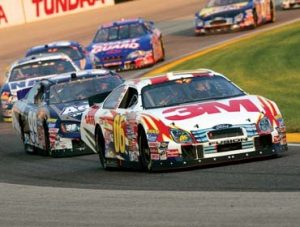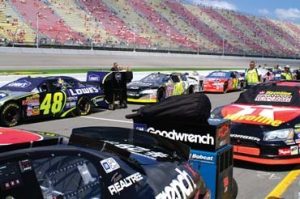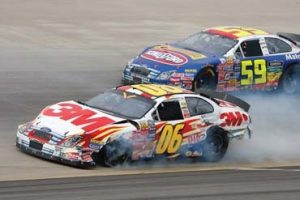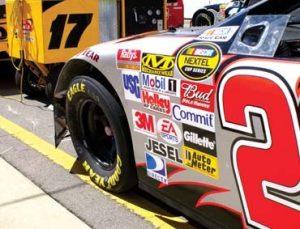Vehicles + Vinyl
A Day at the Race
Dressing up a NASCAR event is big business.
Published
17 years agoon
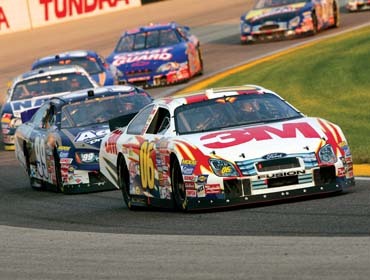
The image of National Assn. for Stock Car Auto Racing (NASCAR) has undergone a Pygmalion-like transformation in recent years. The days when car owners ran low-budget enterprises from their hip pockets are long past. Now, the cars race on paved ovals, rather than early-era dirt tracks, and each speedway offers unique nuances, such as longer straightaways and steeper grades at the turns.
Moreover, husky good ol' boys have been supplanted (mostly) by svelte, telegenic drivers, which broadened NASCAR's appeal (translation: gearhead wives and girlfriends now watch and attend races in much greater numbers).
In August, four ST staffers – myself, Publisher Wade Swormstedt, Senior Art Director Jeff Russ and Editorial Assistant Curtis Penick – trekked north to the Michigan International Speedway to attend the Nextel Cup's GFS Marketplace 400 race. Our journey revealed a graphic cornucopia of cars, haulers and pit crews that bolsters the drivers' marketability and the sponsors' brands. Above all, the transformation has helped drive NASCAR into the cultural stratosphere alongside "traditional" spectator sports.
NASCAR background
In 1948, when Bill France Sr. founded NASCAR, the earliest cars were true "stock cars." Other than minor engine modifications, the cars racing on the beach course at the original Daytona International Speedway differed little from the comparable make and model on the showroom floor. The early cars raced on rough, dirt tracks, and a token modification permitted reinforced steel plates to prevent lug nuts from ripping into wheel rims.
In 1952, Pure Oil Co. developed the first racing tire, and two-way radios first linked drivers to their pit crews. Other '50s improvements included the "small-block" V8 engine, which minimized bulk and enhanced speed, and roll bars, which stiffened the cars' chassis and improved handling. By the early 1960s, several 50,000-plus-fan speedways were built in Florida, North Carolina, Georgia and California.
Racetracks mushroomed across the country in the 1970s, and existing tracks also grew to accommodate six-figure crowds. As the industry became increasingly competitive, financially troubled carmakers, such as Hudson and Kaiser, dropped out, and GM, Chrysler and Ford streamlined the number of makes they entered into the field.
AdvertisementThrough corporate sponsorship – Winston served as the longtime backer of the senior NASCAR circuit, before Nextel assumed the position in 2004 — Busch sponsors the second-tier racing series, and, through its Craftsman tool brand, Sears bought sponsorship of the truck-racing circuit.
Through these sponsorships and increased TV revenue and viewership, drivers began to develop their own large followings. Rapt audiences watched as racing icons Richard "the King" Petty, Dale "the Intimidator" Earnhard and "Awesome" Bill Elliott forged their legend over NASCAR's grueling, 30-plus-week season, and the fans' allegiances to today's Nextel Cup stars, such as Jeff Gordon, Dale Earnhardt Jr. and Tony Stewart, have grown increasingly pronounced.
Dressing the cars
In NASCAR's early days, a racecar's paint job often acquiesced to car modifications – corporate sponsorships were less prevalent in the early days. As image-conscious corporations began supporting NASCAR teams, accurate color rendering became more important.
"To the good old boys in racing's old days, red was just red," explained John McKenzie, CEO of High Point, NC-based Motorsports Designs, which outfits at least 20 Nextel Cup teams for every race. "But, if an advertising manager for Budweiser or Coca-Cola was investing in a car sponsorship, the shade of red suddenly became a lot more important."
Because paint often exhibited glare on the racetrack, and each car was at the mercy of impact from other drivers' jockeying for position – thus the old racing colloquialism, "swapping paint" – car owners sought more durable processes that also offered more accurate color. Thus, screenprinting supplanted paint as the primary car-decoration method in the 1970s (although metallic, custom paints remain a basecoat for many NASCAR vehicles) and remained the industry standard for more than two decades.
Advertisement"Screenprinting has always been cost-effective for the long run of logos and decals that come with outfitting a NASCAR team for the season," McKenzie said.
Motorsports Designs entered the NASCAR fray in 1982, when it created graphics for Richard Childress Racing's Piedmont Airlines car. Predictably, as digital-printing technology emerged in the late 1990s, the shop wholeheartedly embraced it for all NASCAR vehicles, with the exception of cars decorated with "neon" vinyl, whose bright films are more conducive to screenprinting (the shop also continues to screenprint for Automobile Racing Club of America teams and other, minor-circuit customers).
The company outputs two types of inkjet-printed graphics – cut inkjet prints with secondary sponsors' vinyl decals that Motorsports Designs' installation team affixes to the base print, or RaceWraps™, the company's proprietary system that lays out the full decal complement into a single, contiguous wrap.
For the traditional inkjet prints, the company uses various embossed-adhesive films, paired with 3M's 8518 gloss or MACtac's LEF 3681 high-gloss overlaminate. For its RaceWraps, Motorsports employs 3M Industrial Adhesives & Tapes Div.'s cast, 2-mil Controltac™ IJ180C-10 repositionable film with Comply™ adhesive.
To output the prints, the company uses a complement of Océ (Chicago) Arizona 180, |2324| (Meridith, NH) UltraVu® 150 and Mimaki USA (Suwanee, GA) JV3, solvent-ink printers. All told, a season's work for a team entails roughly 40 prints for both the team's primary and backup racecars. Though technological breakthroughs have quickened turnaround – McKenzie said the shop sometimes outputs three RaceWraps in a single day to meet demand – he lauded modern, superior materials.
"The greatest improvement with the inkjet-printing process has been the inks," McKenzie said. "Their color spectrum is so broad and deep today, and we have more PMS matches to work with than ever before. Plus, the media is far more durable, and a repositionable adhesive makes the installers' job so much easier."
AdvertisementWhile the cars that zoom every Sunday command the public eye, other graphic components demand attention. Motorsports Designs also fabricates graphics for the cars' haulers, pit-row contingent and garage. Nick Woodward, Motorsports' sales manager, said the company overlaps 13 panels by 1⁄8 in. to decorate the approximately 13 x 54-ft. haulers. He noted this process is somewhat easier than wrapping racecars because the hauler's surface poses fewer curves.
The company die-cuts the inkjet graphics, which are fabricated with the aforementioned 3M film, and affixes them with a pressure-sensitive laminate to the surface. Typically, these graphics will be installed onsite approximately two weeks prior to a race, although, as is universal with any client, quick-turnaround jobs due to last-minute graphic changes or any number of logistical snafus abound.
A new, much-publicized wrinkle in the Nextel Cup schedule has proven beneficial for the company. In 2004, NASCAR introduced the Chase, which places the circuit's top-10 points leaders in a "showdown" mode, and will tabulate the points weekly until the season concludes in late November with the Ford Championship weekend at the Miami-Homestead Speed-way.
Motorsports Designs fabricated graphics for five teams that advanced to the Chase, and garnered extra work for the finale, for which the teams ordered banners, custom hauler graphics and other celebratory paraphernalia in anticipation of winning the season's points battle.
The future?
Currently, McKenzie estimates 30% of a Nextel Cup field any given Sunday is outfitted with a RaceWrap or similar competitors' product, and roughly half the competitors sport inkjet-printed graphics. By the end of the decade, he predicts that virtually all of the field will comprise digital graphics.
Currently, Chevrolet, Ford and Dodge are the sole makes in the NASCAR field. Next year, befitting its global stature as the second-most prolific carmaker, Toyota will enter the field as three teams adopt their prototype.
In another significant development, NASCAR is introducing a next-generation "car of tomorrow" that will compete in 16 races during the 2007 racing season and 26 races in 2008 before becoming the exclusive car in 2009. According to NASCAR officials, the new vehicle enhances driver safety. Key features include energy-absorbent door panels, a rear wing to enable safer side-by-side racing, and panels that mimic production cars. McKenzie sees the change as entirely positive.
"Not only will it increase driver safety, it will be easier for us because the cars will be more uniform," he said.

SPONSORED VIDEO
Introducing the Sign Industry Podcast
The Sign Industry Podcast is a platform for every sign person out there — from the old-timers who bent neon and hand-lettered boats to those venturing into new technologies — we want to get their stories out for everyone to hear. Come join us and listen to stories, learn tricks or techniques, and get insights of what’s to come. We are the world’s second oldest profession. The folks who started the world’s oldest profession needed a sign.
You may like

4 of the Most Fun Sign Projects in Years

Sign Pro’s Phrase Coaches Customers with Bad Ideas

2024 Sign Contest Open for Submission
Subscribe

Bulletins
Get the most important news and business ideas from Signs of the Times magazine's news bulletin.
Most Popular
-

 Paula Fargo2 weeks ago
Paula Fargo2 weeks ago5 Reasons to Sell a Sign Company Plus 6 Options
-

 Real Deal1 week ago
Real Deal1 week agoA Woman Sign Company Owner Confronts a Sexist Wholesaler
-

 Photo Gallery2 weeks ago
Photo Gallery2 weeks ago21 Larry Albright Plasma Globes, Crackle Tubes and More
-

 Projects1 week ago
Projects1 week agoGraphics Turn an Eyesore Cooler Into a Showpiece Promo in Historic Plaza
-

 Business Management1 week ago
Business Management1 week ago3 Things Print Pros Must Do to Build Stronger Relationships in the Interiors Market
-

 News24 hours ago
News24 hours ago2024 Sign Contest Open for Submission
-

 News1 week ago
News1 week agoPattison ID New Name of Five Companies
-
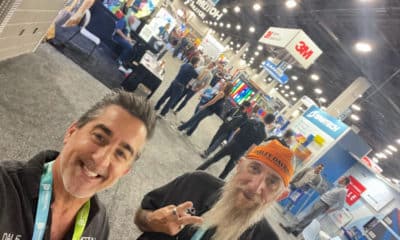
 Dale Salamacha5 days ago
Dale Salamacha5 days agoWhat Makes the Perfect Sign Business Partnership
